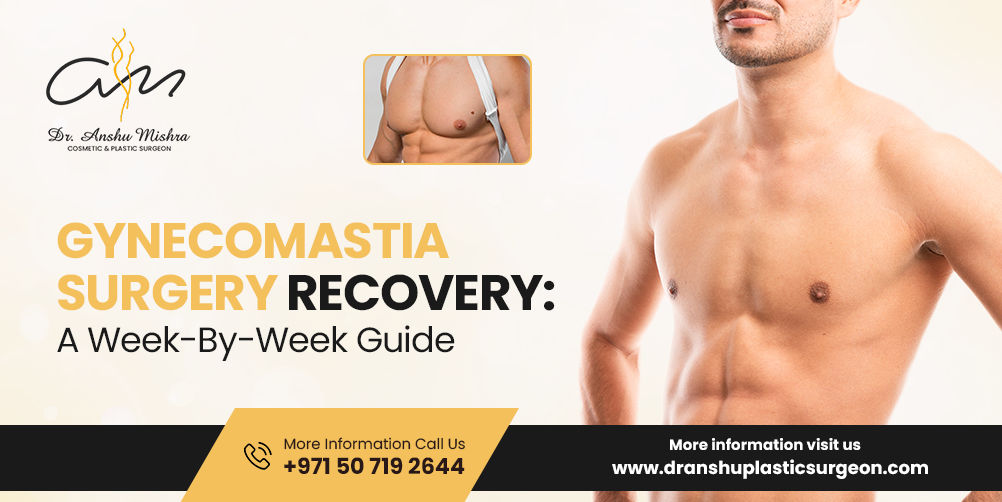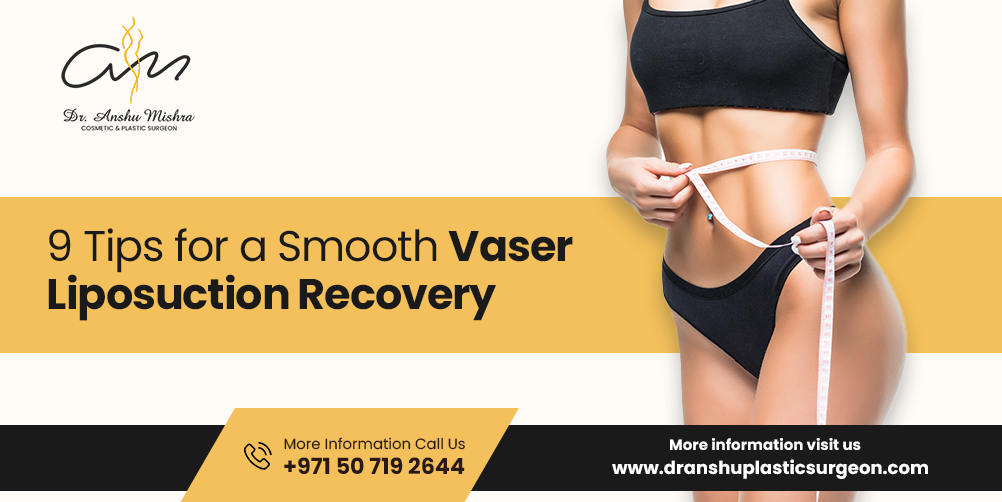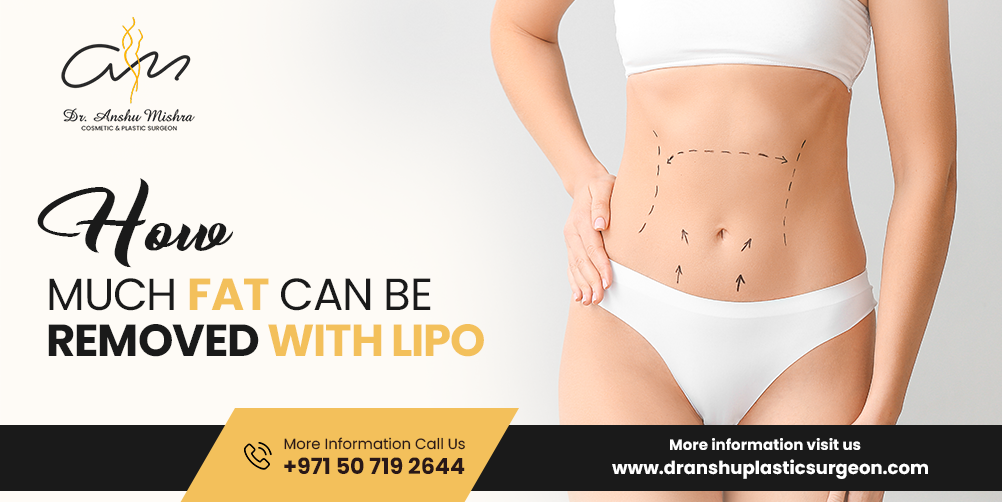Gynecomastia surgery recovery involves rest, wearing compression garments, and avoiding strenuous activities. Initial discomfort, swelling, and bruising are common, typically subsiding within weeks. Patients usually return to normal activities within a few days, with full recovery in about six weeks. Follow-up visits ensure proper healing and optimal results.
Gynecomastia is a condition where men experience enlargement of breast tissue. It affects many men, often causing significant uneasiness and low self-esteem. Consulting with doctor to explore treatment options can provide relief and help restore confidence, but understanding the recovery process after surgery is essential to achieve the best possible outcome. Here we, Dr Anshu Mishra & her team, are providing a detailed, week-by-week guide to help you through your recovery journey from gynecomastia surgery.
Table of Contents
TogglePre-Surgery Preparations
First, let’s understand how to prepare for surgery, and then we will explore the week-by-week recovery process.
- Consultation: Find the best surgeon for the gynecomastia procedure and discuss the procedure, risks, and the expected outcomes. Make a list of questions you have related to the procedure, your grade of gynecomastia; and results you might want to ask with your surgeon.
- Medical Check-Up: The Doctor will run normal tests to ensure that you’re in good health and ready for surgery. This includes blood tests, hormones or any other evaluations.
- Stop Smoking: Stop smoking and alcohol intake at least 3 weeks before the surgery till the time you fully recover.
- Arrange Help: You will need family members or friends to support you post-surgery,, especially for the first few days.
- Comfort at Home: Arrange everything at home for your recovery space, like comfortable pillows, books, and easy access to essentials. You will need positivity and things to engage mentally post-surgery.
Week 1: The Initial Phase
-
Day 1-2: Post-Surgery
- Rest and Recover: Rest is an important element in any surgery, you’ll feel groggy due to anaesthesia, so take proper rest and medication to recover.
- Pain Management: Due to surgery, you’ll experience pain and discomfort. Take medication prescribed by your doctor to manage this.
- Compression Garment: You’ll be fitted with a compression garment to minimise swelling and support your chest as it heals.
- Limited Movement: Your movement will be restricted for a few days and you should avoid strenuous activities. You can walk slowly, but avoid lifting your arms above your shoulders.
-
Day 3-7: Settling In
- Follow-Up Visit: Schedule regular visits to your surgeon to ensure recovery is progressing well. The doctor might check stitches and change dressings. Also, suggest if extra care is required.
- Medication: Continue prescribed medications until recovered fully. Medication is important to prevent you from catching an infection and also to manage pain better.
- Light Activities: The doctor might suggest for some light movements, you can gradually increase light activities, but avoid any heavy lifting or strong exercise.
- Hygiene: Maintain hygiene by cleaning the incision site and keeping it dry to avoid infections. You may be advised to take sponge baths initially.
Week 2: Gradual Improvement
- Swelling and Bruising: You’ll experience swelling and bruising initially and it will begin to subside in 2nd week. However, continue wearing your compression garment.
- Pain Reduction: In 2nd week pain should be minimal, possibly no medication would be required by now.
- Gentle Exercise: Walking provides movement to the whole body, light walking is encouraged for blood circulation, but avoid energy-demanding activities.
- Diet: Make a weekly menu for a healthy diet rich in proteins, vitamins, and minerals including fruits, greens and whole grains for speedy recovery.
Week 3: Close to Normalcy
- Physical Comfort: Once your body starts healing, you’ll feel more comfortable. Moving around will be easy.
- Routine Activities: Start your routine activities gradually, do not exhaust yourself, and listen to your body.
- Incision Care: Apply silicon gel on your incision site, to improve the appearance of the scar.
- Mental Health: Feeling uneasy or miserable during recovery is normal. Surround yourself with people who lift up your mood, engage in activities that boost your confidence.
Week 4: Increased Mobility
- Physical Activity: Apart from heavy lifting, start incorporating more physical activities. You will feel better and more energetic.
- Garment Use: Check with your surgeon about compression garments, they may recommend wearing them for a few more days to support your healing.
- Follow-Up Appointment: Fix a time to visit a doctor for a checkup, follow-up visits are good for monitoring your progression.
- Scar Care: You can ask for scar treatment medication with your doctor, applying ointment will help minimise scar appearance.
Week 5-6:Strength Gaining
- Exercise: Light cardio and lower body workout are advisable at this stage. Do not attempt upper body workouts until your doctor gives the green light.
- Scar Healing: Continue recommended treatment for scar healing. If you apply medication prescribed by a doctor, scars will fade early.
- Monitor Changes: If you observe any unusual changes or symptoms in your chest area report to your doctor for early diagnosis.
Week 7-8:Full Recovery Phase
- Regular Activities: In the 7th and 8th weeks, you’ll be almost recovered and back to your normal routine. Doing regular activities without any hindrance would be possible now.
- Exercise Routine: You must be missing your upper body workout, start introducing upper body exercises from week 8th, first start with lighter weights and lower intensity.
- Compression Garment: The doctor might limit the use of compression garments, depending on your healing progress.
- Final Results: Time to notice the final results after surgery on your body. Although you might still experience slight swelling in your chest area, this will gradually subside over time.
Beyond Week 8: Long-Term Recovery and Maintenance
- Full-Fledged Activities: Most patients start doing all activities, including strong exercise, by the 8–12-week mark. They feel fully recovered and back to normal state.
- Regular Check-Ups: Though you are fully recovered, it’s advisable to schedule regular check-ups with your surgeon to ensure everything is ok.
- Healthy Lifestyle: To manage your results and look best maintain a healthy lifestyle, including regular exercise, a balanced diet, and avoiding things that can cause hormonal imbalance.
Tips for a Speedy Recovery
- Doctor’s Advice: Doctors advise the best possible recovery care for proper healing, always follow the post-surgery instructions provided by your surgeon.
- Stay Hydrated: Keep yourself hydrated for a healthy recovery, drink plenty of water and other liquids to help your body heal.
- Healthy Diet: A balanced diet is important for a healthy body, focusing on nutritious foods that promote healing and provide energy could be a good idea.
- Smoking and Alcohol: Quit smoking and drinking to recover fast. These habits impact adversely on your health.
- Be Patient: Recovery is a time-consuming process, it’s essential to be patient and positive to heal properly.
Concerns During Recovery
- Swelling and Bruising: After gynecomastia surgery, it is normal to experience swelling and bruising, which will be gone with proper medication gradually.
- Pain and Discomfort: Pain is common post-surgery and manageable with medication and subsides over time.
- Emotional Concerns: Patients often get emotional during recovery, you should seek support from family, friends and surgeons for positivity.
- Anxiety: Waiting to see the final results creates anxiety, recovery takes several months to show the final results. Be patient and give your body time to adjust.
Emotional and Psychological Aspects of Recovery
Recovering from surgery isn’t just a physical process; it’s an emotional one too. Many men feel a mix of emotions ranging from relief and happiness to anxiety and impatience. Here are some tips to handle the psychological aspects:
- Be Kind to Yourself: Understand that it’s okay to feel down during recovery. Don’t be hard on yourself and take some rest, read/ watch something nice and heal.
- Talk About It: Connect and share your feelings with friends, family, or a therapist. Sometimes just sharing your feelings can provide relief and support.
- Join Support Groups: Consider joining online forums or local support groups for gynecomastia patients, who have undergone similar surgery. Sharing experiences and advice can be incredibly comforting.
- Stay Positive: Focus on the long-term benefits of the surgery and keep a positive mindset. Celebrate small milestones and progress in your recovery.
- Track Your Progress: You can journal your experiences of the recovery process. Note any changes, improvements, or setbacks. Writing down your feelings will provide some relief and this information will be useful for follow-up visits with your surgeon.
- Customise Your Comfort: Set up a comfortable recovery space with items that make you feel good, such as your favourite books, movies, or music. Small comforts can make a big difference in your recovery experience.
- Plan for Help: Don’t hesitate to ask for help from friends or family members. Whether it’s assistance with daily tasks or emotional support, having a reliable support system can ease your recovery journey.
Final Thoughts
The Gynecomastia surgery recovery journey is time-consuming and requires patience and proper care. This week-by-week guide will be helpful to navigate the recovery process with more confidence and ease. Stay connected with your surgeon for any concerns or questions regarding procedure, or post-surgery recovery. Your health and well-being are paramount, and taking proper steps to recover will ensure you achieve the best possible results from your surgery.
Dr Anshu Mishra is an expert in Gynecomastia surgery and runs a clinic in Dubai. If you are looking for the best surgeon for Gynecomastia and want to have a second opinion you can visit her. After a thorough examination, she offers the best possible solution for any problem. She is one of the best plastic surgeons in Dubai and has performed various cosmetic surgeries. Her expertise in Gynecomastia makes her the best choice for anyone looking to get the surgery done.
Dr Mishra ensures patient’s safety while delivering positive results. She suggests the best options to achieve the patient’s goal. With 11 years of experience in surgery, she has treated many patients successfully. If you want to get a consultation in Dubai ,look no further and visit Dr Anshu Mishra for best results.
FAQs
-
How should I handle my post-operative discomfort and swelling?
Swelling and pain are typical aspects of the healing process. Your surgeon will probably recommend painkillers to treat them; follow their instructions carefully. A vital part of minimising swelling and promoting recovery is the compression garment that is given after surgery. It could also be advised to apply cold compresses to ease pain. During the early healing phase, avoid any activity that may cause oedema, such as heavy lifting or intense exercise.
-
After gynecomastia surgery, when can I get back to my regular activities?
After surgery, most patients can gradually return to their regular, non-strenuous activities two to three weeks later. You could have a noticeable decrease in discomfort and oedema by the second week, which will enable you to move about more easily. However, until your surgeon provides the all-clear, it’s crucial to avoid strenuous physical activities, especially those involving the upper body. Depending on how quickly your body heals, a full recovery, which includes returning to all regular activities, usually takes four to six weeks.
-
Is wearing a compression garment necessary, and for how long?
Yes, during the initial several weeks following surgery, wearing a compression garment is essential. This clothing increases comfort levels, promotes tissue repair and skin retraction and reduces oedema. Typically, you’ll have to wear it constantly for the first three weeks, and then maybe throughout the day or night for another two to three weeks, depending on your surgeon’s instructions. For best effects and a more seamless recovery, the compression garment must be used consistently.
-
What are the indicators of a problem during recovery, and when should I see my surgeon?
The early detection of symptoms is crucial, even if consequences are uncommon.If you have extreme swelling, redness, warmth, drainage from the incision site, intense pain that is not going away, or a high fever, get in touch with your surgeon right away. Furthermore, you should consult a doctor right away if you observe any strange changes in the look of your chest, such as asymmetry or large lumps.
-
How can I care for the incision areas to reduce scarring?
Keep the areas where incisions were made dry and clean to reduce scarring. Once the wounds have fully healed, your surgeon may advise using silicone gel or scar therapy ointments. The scars may deepen and become more apparent if they are exposed to direct sunlight. The scars should lessen in visibility and dissolve with time with the right treatment. Avoiding picking at scabs and using any abrasive materials on the incision areas is also crucial.
-
What lifestyle adjustments should I think about making for a speedy recovery?
A healthy lifestyle may make a big difference in your recuperation. To encourage tissue healing, concentrate on eating a well-balanced diet high in vitamins, minerals, and protein. Maintaining proper hydration is also crucial. Avoid alcohol and tobacco since these might promote problems and hinder recovery. To increase circulation, light walking is advised; but, until your surgeon gives the all-clear, heavy lifting and intense activity should be avoided. Achieving the greatest result also largely depends on keeping a good outlook and exercising patience while you heal.















